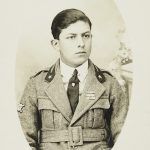Diary of di Folco’s experiences in the Italian Army, 1918-21
07 Jun 2016, by in RelationsCarlo Pirozzi (TML Team)
A fascinating and rare diary written by a Scots-Italian soldier, Robert Di Folco (1899-1963) fighting in Italy during the closing year of the First World War, 1918. Robert, whose real name was Libero, was born in Italy in 1899, in a small village called Piedimonte San Germano, at the southern end of the Lazio region. Soon after his birth, his family migrated to Scotland and settled in St Andrews.
This diary, written retrospectively, was dated February 1918 – 1921 but consists only of the first part, covering mostly the year 1918 until the Armistice on the 4th November. Unfortunately, the second notebook was lost or never written, but from the existing diary we learn that immediately after the end of the War Robert and his comrades ‘got ready to march towards to Fiume on the Adriatic’. Photos from the family archive bear witness to his participation in the seizure of the city of Fiume on the Dalmatian coast by the Italian poet Gabriele D’Annunzio on 12 September 1919 (related to this, see the article written by his son John Di Folco). In place of his father, who had been officially called up, Robert volunteers and leaves St Andrews, ‘The old gray city by the sea’, to arrive in Turin on February 4th 1918. First impressions of Italy are stunning, ‘a nicer country I’d never seen, for its Beauty, Building, and scenary ‘. He is struck in particular by the Italians themselves, ‘dressed in bright colors, and men with ear rings, Brigands, etc ‘. At the first opportunity, he visits Cassino wher, through chance encounters, he is fortunate to meet for the first time two of his cousins and their family. He is surprised again by the sudden arrival from Scotland of his father, who has come to visit.
Assigned to the 54th Infantry Regiment and based in the town of Aosta, he soon falls in with a group nicknamed ‘the Allies’, made up of ‘Irish, Scotch and English’. Robert tells us of his painful war experiences and life in the trenches, in particular detailing dates, times and places of bloody bombings along the Piave River where, in June of 1918, he was wounded in the leg and hospitalized. He also records other aspects of daily life such as the meals of ‘bully beef and biscuits’, the initial difficulty learning Italian (a language that with the passage of time will become ‘very sweet and easy’), the medals awarded, and the deep friendship formed with ‘Cockney’, whose real name we will never know. After the hospital stay, ‘Jack’, as Robert is nicknamed, returns immediately to the front line, where prolonged and intense bombing continues until the Armistice on the 4th of November 1918. Surprisingly, his only comments on this momentous event is the succinct line, ‘When the armistice was signed we nearly went out of our heads with joy’. In fact, Robert includes no other mention of his and his fellow soldiers’ state of mind nor of the end of the War. We know only that after a few days of rest he was ready to march towards Fiume.
We highlight in particular one of the images you can see in the photo gallery: a battlefield map sketched in watercolour by Robert. The drawing illustrates the battlegrounds around the Piave River, showing trenches, embankments, defensive walls and the River Piave itself. This battle, fought between 15th and 23rd June 1918, was a decisive victory for the Italian Army during World War I. He also included in his diary a translation into English of “La Leggenda del Piave”, the iconic Italian patriotic song written after the battle.
An audio portrait of Robert (Libero) Di Folco by his son John Di Folco (2016)
John Di Folco has kindly given us a thoughtful reflection on his father’s war-time experiences in Italy. This audio recording also reveals how, despite John’s limited experience of Italy and the Italian language, the strands of personal family connection that exist have contributed to who he is, including, as he mentions, his life-long fondness for the Italian liqueur Fernet Branca.
Note
Di Folco’s diary is deposited at the National Library of Scotland in Edinburgh. The photographs, of which only some are displayed in the photo gallery, are preserved in the Archives of the University of St. Andrews. The diary will be published and edited by Dr Carlo Pirozzi.











Sorry, the comment form is closed at this time.